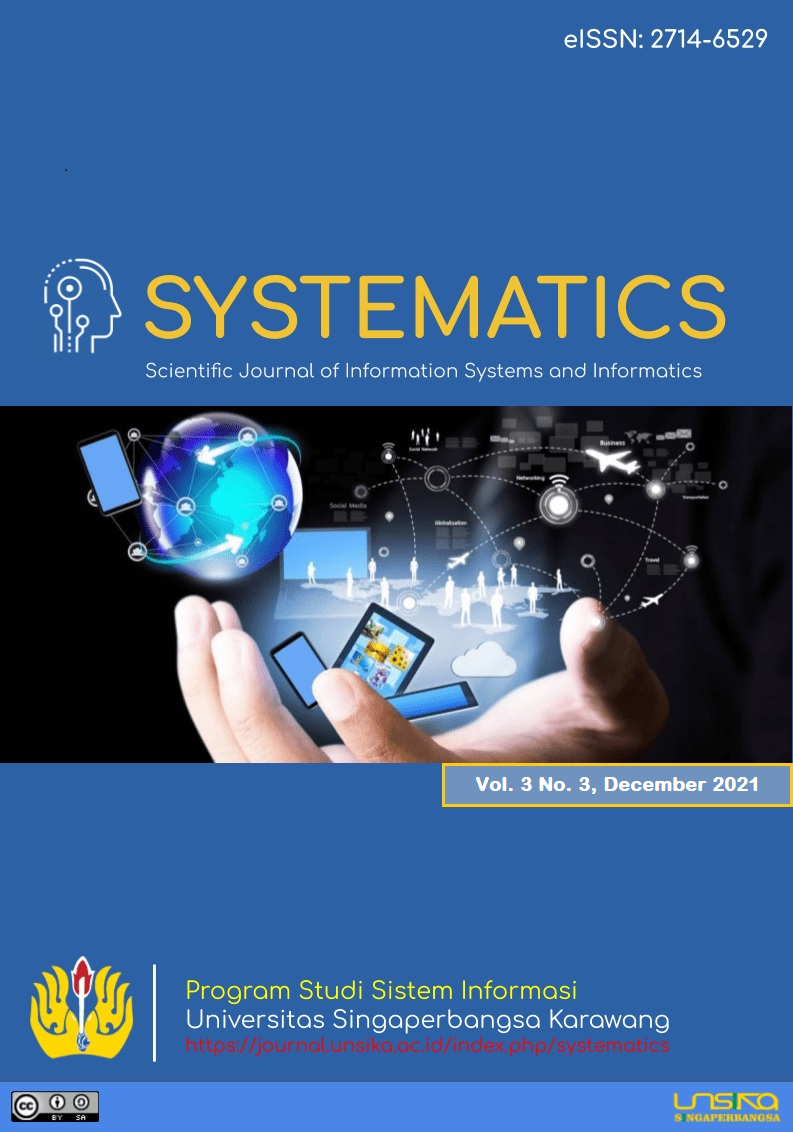Analysis of the Relationship between Public Sentiment on Social Media and Indonesian Covid-19 Dynamics
Analisis Hubungan Sentimen Publik di Media Sosial dengan Dinamika Covid-19 Indonesia
DOI:
https://doi.org/10.35706/sys.v3i3.6075Abstract
The bad side of the open access nature of social media is that it frees anyone to have an opinion as they please and is often accompanied by other agendas such as spreading panic, false information, fake news, hate speech and even distorting public opinion. This condition can be fatal in the pandemic era where public opinion can worsen the pandemic situation. Therefore, it is important to know whether it is true that changes in public sentiment in response to news on social media can affect the dynamics of the spread of COVID-19. We use sentiment analysis using machine learning methods to extract daily sentiment data and test its correlation with daily Covid-19 case data in Indonesia. The results of the associative hypothesis test with a Pearson correlation value of 0.151 show that public sentiment on social media towards the news of the COVID-19 variant is positively correlated with the dynamics of the daily Covid-19 cases. Therefore, the author invites all social media users, including the author himself, to be more vigilant and careful in giving opinions and accepting other people's opinions on social media.
Downloads
References
WHO, “WHO Coronavirus (COVID-19) Dashboard,” Geneva World Health Organization., 2020.
W. McKibbin and R. Fernando, “The economic impact of COVID-19,” Econ. Time COVID-19, vol. 45, no. 10.1162, 2020.
S. Maital and E. Barzani, “The global economic impact of COVID-19: A summary of research,” Samuel Neaman Inst. Natl. Policy Res., vol. 2020, pp. 1–12, 2020.
O. Dyer, “Covid-19: Indonesia becomes Asia’s new pandemic epicentre as delta variant spreads,” BMJ, vol. 374, p. n1815, Jul. 2021.
A. Wong, S. Ho, O. Olusanya, M. V. Antonini, and D. Lyness, “The use of social media and online communications in times of pandemic COVID-19,” J. Intensive Care Soc., vol. 22, no. 3, pp. 255–260, Aug. 2021.
H. Sahni and H. Sharma, “Role of social media during the COVID-19 pandemic: Beneficial, destructive, or reconstructive?,” Int. J. Acad. Med., vol. 6, no. 2, pp. 70–75, Apr. 2020.
A. Clark, “COVID-19-related Misinformation: Fabricated and Unverified Content on Social Media,” Anal. Metaphys., no. 19, pp. 87–93, 2020.
K. Chakraborty, S. Bhattacharyya, and R. Bag, “A Survey of Sentiment Analysis from Social Media Data,” IEEE Trans. Comput. Soc. Syst., vol. 7, no. 2, pp. 450–464, Apr. 2020.
E. Miranda, M. Aryuni, R. Hariyanto, and E. S. Surya, “Sentiment Analysis using Sentiwordnet and Machine Learning Approach (Indonesia general election opinion from the twitter content),” in 2019 International Conference on Information Management and Technology (ICIMTech), 2019, vol. 1, pp. 62–67.
F. S. Pamungkas and I. Kharisudin, “Analisis Sentimen dengan SVM, NAIVE BAYES dan KNN untuk Studi Tanggapan Masyarakat Indonesia Terhadap Pandemi Covid-19 pada Media Sosial Twitter,” PRISMA Pros. Semin. Nas. Mat., vol. 4, pp. 628–634, Feb. 2021.
F. Z. Ahmad, M. F. S. Arifandy, M. R. Caesarardhi, and N. A. Rakhmawati, “Bagaimana Masyarakat Menyikapi Pembelajaran Tatap Muka: Analisis Komentar Masyarakat pada Media Sosial Youtube Menggunakan Algoritma Deep Learning Sekuensial dan LDA,” J. Linguist. Komputasional, vol. 4, no. 2, pp. 40–46, 2021.
Rifiana Arief and Karel Imanuel, “Analisis Sentimen Topik Viral Desa Penari Pada Media Sosial Twitter Dengan Metode Lexicon Based,” J. Ilm. Matrik, vol. 21, no. 3, Dec. 2019.
B. Vidgen and L. Derczynski, “Directions in abusive language training data, a systematic review: Garbage in, garbage out,” PLOS ONE, vol. 15, no. 12, p. e0243300, Des 2020.
K. Mishev, A. Gjorgjevikj, I. Vodenska, L. T. Chitkushev, and D. Trajanov, “Evaluation of Sentiment Analysis in Finance: From Lexicons to Transformers,” IEEE Access, vol. 8, pp. 131662–131682, 2020.
V. Prabhakaran, A. M. Davani, and M. Díaz, “On Releasing Annotator-Level Labels and Information in Datasets,” ArXiv211005699 Cs, Oct. 2021.
P. Chikersal, S. Poria, and E. Cambria, “SeNTU: sentiment analysis of tweets by combining a rule-based classifier with supervised learning,” presented at the Proceedings of the 9th International Workshop on Semantic Evaluation (SemEval 2015), 2015, pp. 647–651.
I. S. Joyosemito and N. M. Nasir, “Gelombang Kedua Pandemi Menuju Endemi Covid-19: Analisis Kebijakan Vaksinasi dan Pembatasan Kegiatan Masyarakat di Indonesia,” J. Sains Teknol. Dalam Pemberdaya. Masy., vol. 2, no. 1, 2021.
N. Aliyah Salsabila, Y. Ardhito Winatmoko, A. Akbar Septiandri, and A. Jamal, “Colloquial Indonesian Lexicon,” in 2018 International Conference on Asian Language Processing (IALP), 2018, pp. 226–229.
D. H. Wahid and A. Sn, “Peringkasan Sentimen Esktraktif di Twitter Menggunakan Hybrid TF-IDF dan Cosine Similarity,” IJCCS Indones. J. Comput. Cybern. Syst., vol. 10, no. 2, pp. 207–218, Jul. 2016.
W. Budiharto and M. Meiliana, “Prediction and analysis of Indonesia Presidential election from Twitter using sentiment analysis,” J. Big Data, vol. 5, no. 1, p. 51, Dec. 2018.
Downloads
Published
How to Cite
Issue
Section
License
Copyright (c) 2021 SYSTEMATICS

This work is licensed under a Creative Commons Attribution-ShareAlike 4.0 International License.
Authors who publish with this journal agree to the following terms:
- Authors retain copyright and grant the journal right of first publication with the work simultaneously licensed under a Creative Commons Attribution-ShareAlike 4.0 International License. that allows others to share the work with an acknowledgement of the work's authorship and initial publication in this journal.
- Authors are able to enter into separate, additional contractual arrangements for the non-exclusive distribution of the journal's published version of the work (e.g., post it to an institutional repository or publish it in a book), with an acknowledgement of its initial publication in this journal.
- Authors are permitted and encouraged to post their work online (e.g., in institutional repositories or on their website) prior to and during the submission process, as it can lead to productive exchanges, as well as earlier and greater citation of published work (See The Effect of Open Access).







